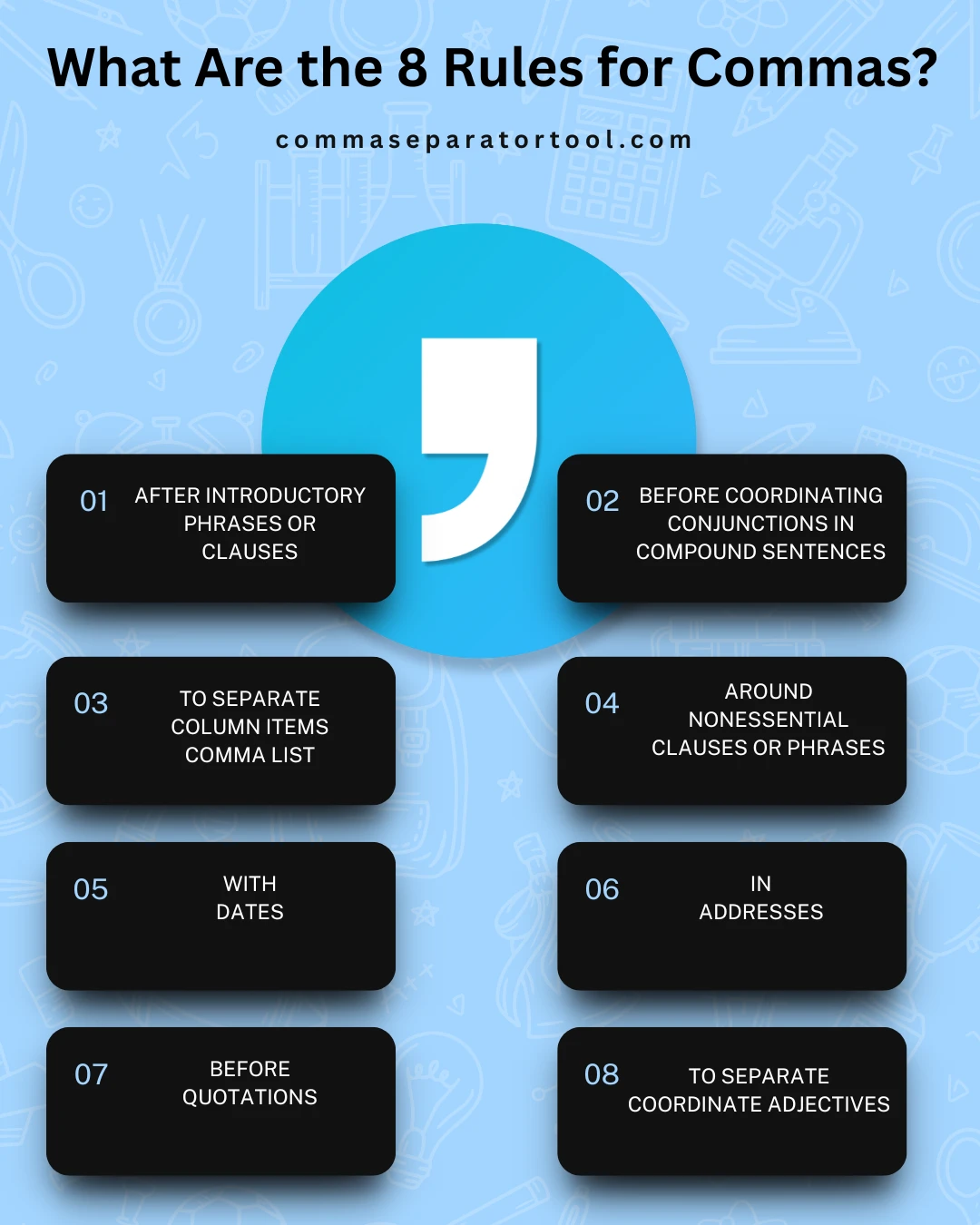When to Use a Comma in a Sentence: Rules and Examples
“When to Use a Comma in a Sentence: using commas after introductory phrases, before coordinating conjunctions in compound sentences, to separate items in a list, and around nonessential clauses.”
What Is a Comma and When to Use a Comma in a Sentence?
A comma is a small punctuation mark that plays a big role in English writing. It separates ideas, adds clarity, and ensures your sentences flow naturally. Wondering when to put a comma in a sentence? Understanding its purpose is the first step. Whether you’re crafting a list or linking thoughts, commas prevent confusion. Let’s explore when to use a comma with practical rules and comma examples sentences to guide you.
What Are the 8 Rules for Commas with examples?
The 8 rules for commas provide a framework for clear, effective punctuation in English writing. Mastering them ensures your sentences are easy to read and understand. Below are the rules, each illustrated with examples:

- After Introductory Phrases or Clauses
Use a comma to separate an introductory phrase or clause from the main sentence. This signals where the setup ends and the core idea begins.
Example: "After finishing my homework, I watched a movie."
Why: The comma after "homework" mimics a natural pause and prevents confusion. - Before Coordinating Conjunctions in Compound Sentences
Place a comma before a coordinating conjunction (e.g., and, but, or, so) when it joins two independent clauses—complete thoughts that could stand alone.
Example: "She wanted to join the team, but she had to finish work first."
Why: It separates two full ideas, avoiding a run-on sentence. - To Separate Items in a List
Use commas to divide items in a series, including an optional Oxford comma before the final "and."
Example: "We need pens, paper, and notebooks."
Why: Each comma keeps items distinct; the Oxford comma (before "and") can clarify meaning, as in "my friends, Tom, and Jerry." Clarity reigns supreme. Tools like Comma Separator Tool can help format column to comma lists effortlessly. - Around Nonessential Clauses or Phrases
Enclose nonessential (nonrestrictive) information—details that add info but aren’t critical to the sentence’s meaning—with commas.
Example: "My sister, who lives in New York, called me yesterday."
Why: "Who lives in New York" is extra; without commas, the clause would imply it’s essential to identify which sister. - With Dates
Use commas to separate elements in a date, especially between the day and year, and after the year in a sentence.
Example: "The event is scheduled for March 15, 2025, at noon."
Why: Commas organize the date’s components and set it off from the rest of the sentence. - In Addresses
Insert commas between parts of an address, like street, city, and state, when written in a sentence.
Example: "Send it to 456 Oak St., Denver, Colorado."
Why: Each comma isolates a specific part, making the location clear. - Before Quotations
Place a comma before a direct quotation to introduce what’s being said.
Example: "She replied, 'I’ll be there soon.'"
Why: The comma separates the speaker’s action from their words, aligning with standard dialogue formatting. - To Separate Coordinate Adjectives
Use commas between adjectives that equally describe a noun and could be joined by "and."
Example: "It’s a cold, windy night."
Why: "Cold" and "windy" both modify "night" independently; no comma is needed if one adjective modifies the other, like "bright red car."
These rules—supported by sources like the Chicago Manual of Style and Purdue OWL—cover the most common comma uses. Applying them with examples like these helps you decide when a comma enhances clarity and flow in your writing.
Tips for Applying Comma Rules
Not sure when to use a comma? Consider:
- Clarity: Does it make the sentence easier to read?
- Pause: Does it reflect how you’d speak?
- Structure: Is it a list, intro, or extra detail?
Final Words
Knowing what is a comma and when to use a comma in a sentence transforms your writing. From introductory phrases to lists, these rules—part of the 8 rules for commas with examples—ensure your ideas shine. Keep practicing, and clarity will follow.
Frequently Asked Questions
What is a comma used for?
A comma separates ideas, clarifies meaning, and organizes sentences—like after intros, in lists, or around extra details.
When to use a comma before 'and' in a list?
Use a comma before “and” in a list (Oxford comma) for clarity, like “cats, dogs, and birds,” though it’s optional.
When to put a comma in a sentence?
Put a comma where it aids readability: after intros, between independent clauses, in lists, or with nonessential info.